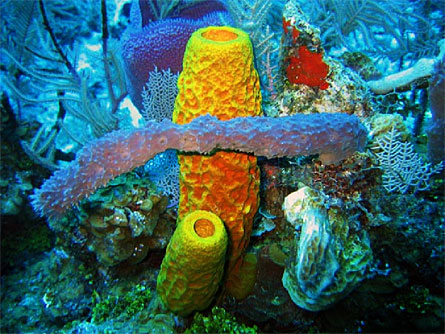Sponges’ secret weapon
An aquatic animal provides a possible new kind of disease resistance
 |
|
Sponges are simple animals that live on the floor of the ocean. Scientists have found a way to use sponges to help fight bacterial infections.
|
| Courtesy of the Twilight Zone Expedition Team 2007, NOAA-OE |
Bacteria are tiny, single-celled organisms. They can live almost anywhere — in soil, water, food or your body. We can cure many types of bacterial infections with the use of medicine called antibiotics, which kill the germy organisms. Unfortunately, some types of bacteria do not respond to these drugs. This resistance can be a big problem for people; if our antibiotics don’t kill the germs, then a bacterial infection may turn deadly. But scientists recently discovered a new way to fight these tough bacteria. And it was in a very unusual place: under the sea.
Peter Moeller is a chemist at the Hollings Marine Laboratory in Charleston, S.C. His team found a place on the ocean floor where all the organisms were dead — except for a sponge.
Sponges are simple aquatic animals, many of which look like tubes. (Historically, humans have used dead sponges for scrubbing and cleaning. But most modern sponges — like the one by your kitchen sink — are made from synthetic, or human-made, materials.)
“How is this thing surviving when everything else is dead?” Moeller pondered as he thought about the lone sponge. He knew that the sea is like a playground for disease. Ocean water is literally swimming with bacteria.
In the body of the sponge, the scientists found a chemical called ageliferin. That chemical is nontoxic. But it might make a new weapon in the fight against bacteria that don’t respond to antibiotics. When the scientists put ageliferin on some particularly tough bacteria in the laboratory and then added antibiotics, the germy organisms died. Ageliferin’s power to resist bacteria can help explain why the sponge is able to survive in a place where other organisms cannot.
In February, Moeller announced that ageliferin might be used against bacteria that threaten people. In the lab, he has found, ageliferin can boost the power of antibiotics. It has shown this booster power against bacteria that cause whooping cough, ear infections and food poisoning. It might also be used to fight bacterial infections that occur among wounded soldiers.
That news is promising. But right now, ageliferin works only in the laboratory. The scientists also don’t know how ageliferin works. But if it works for sponges, it might just work some day for us.







